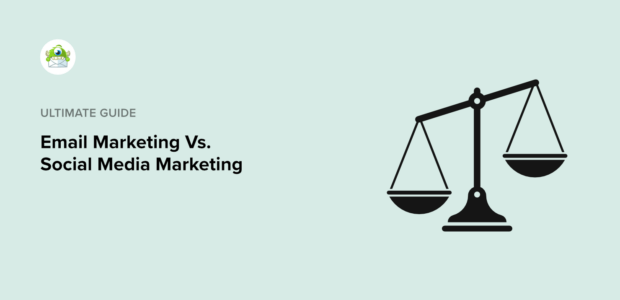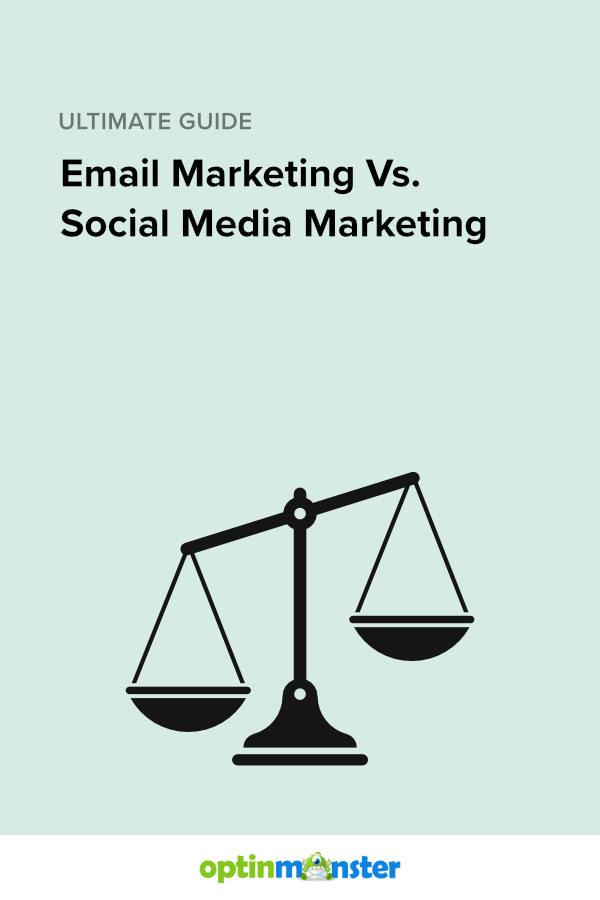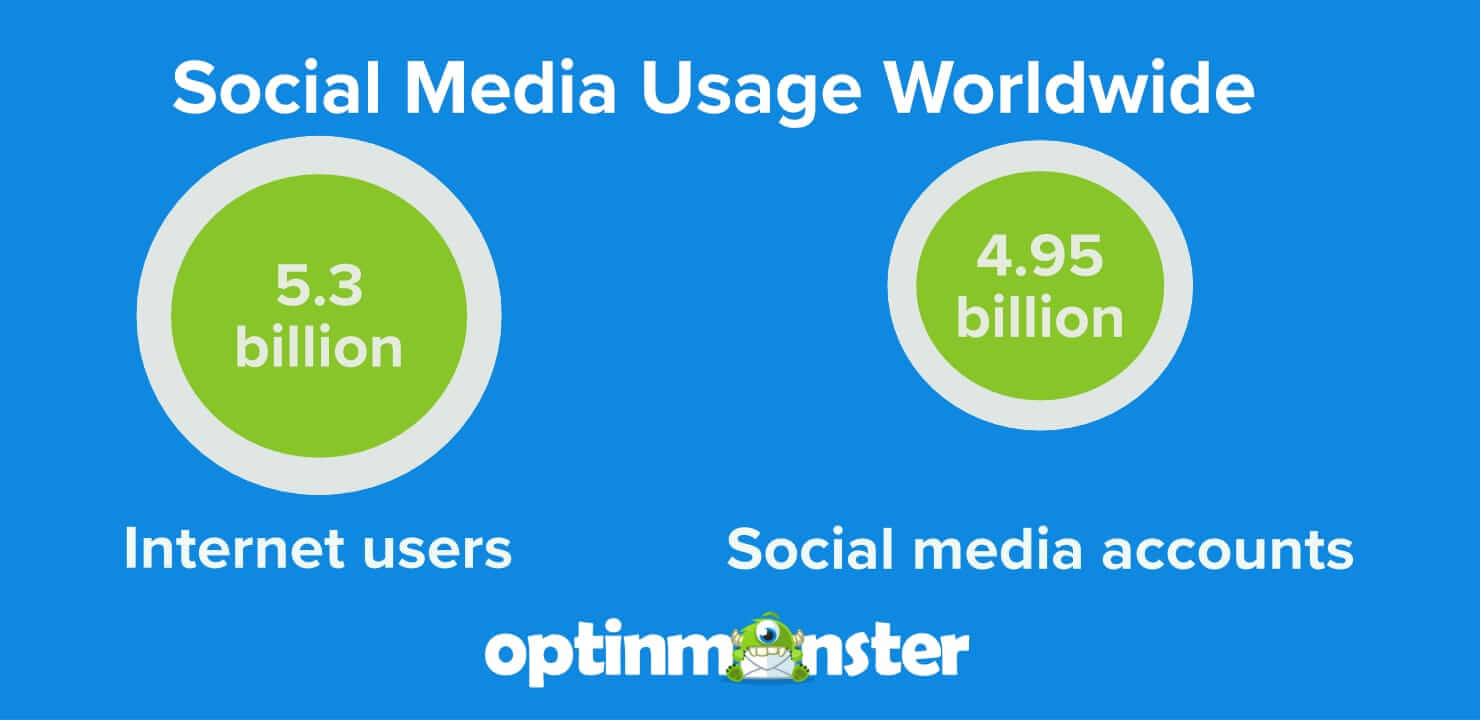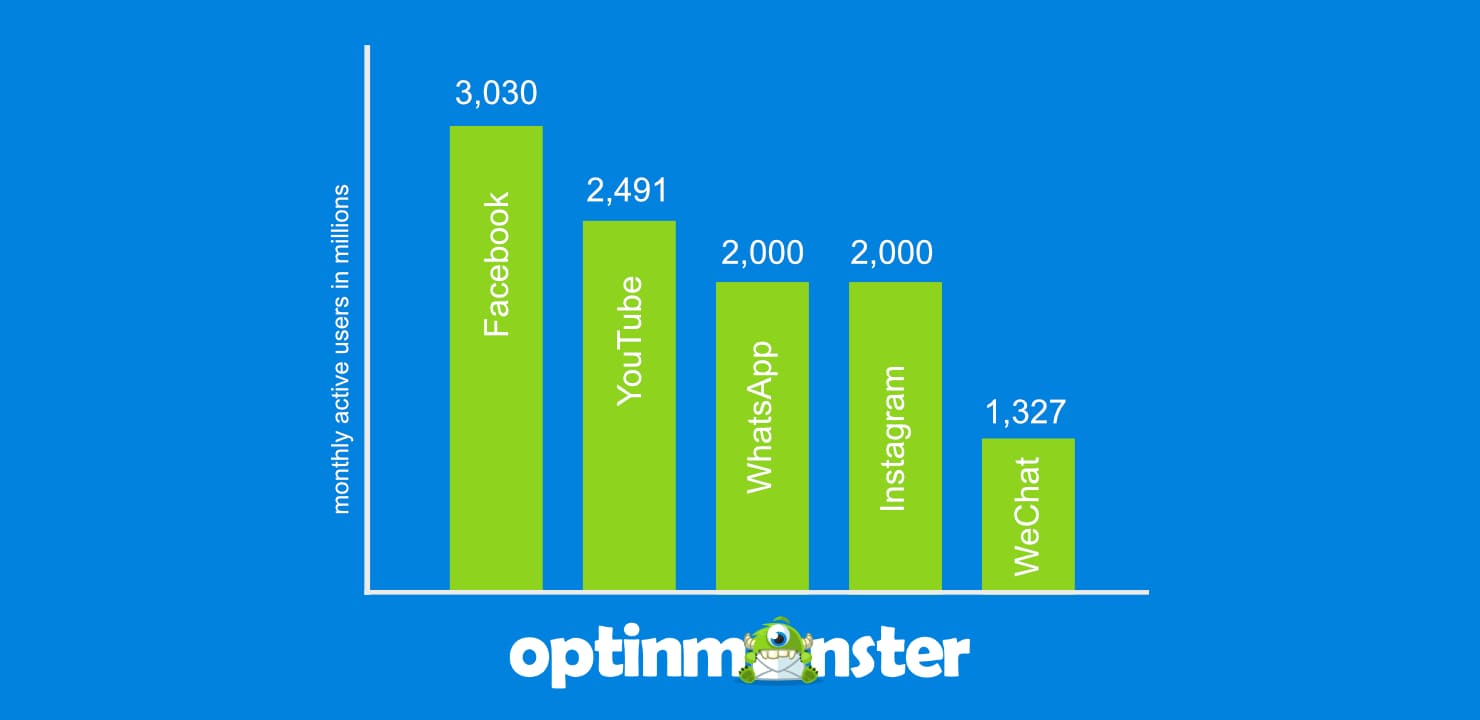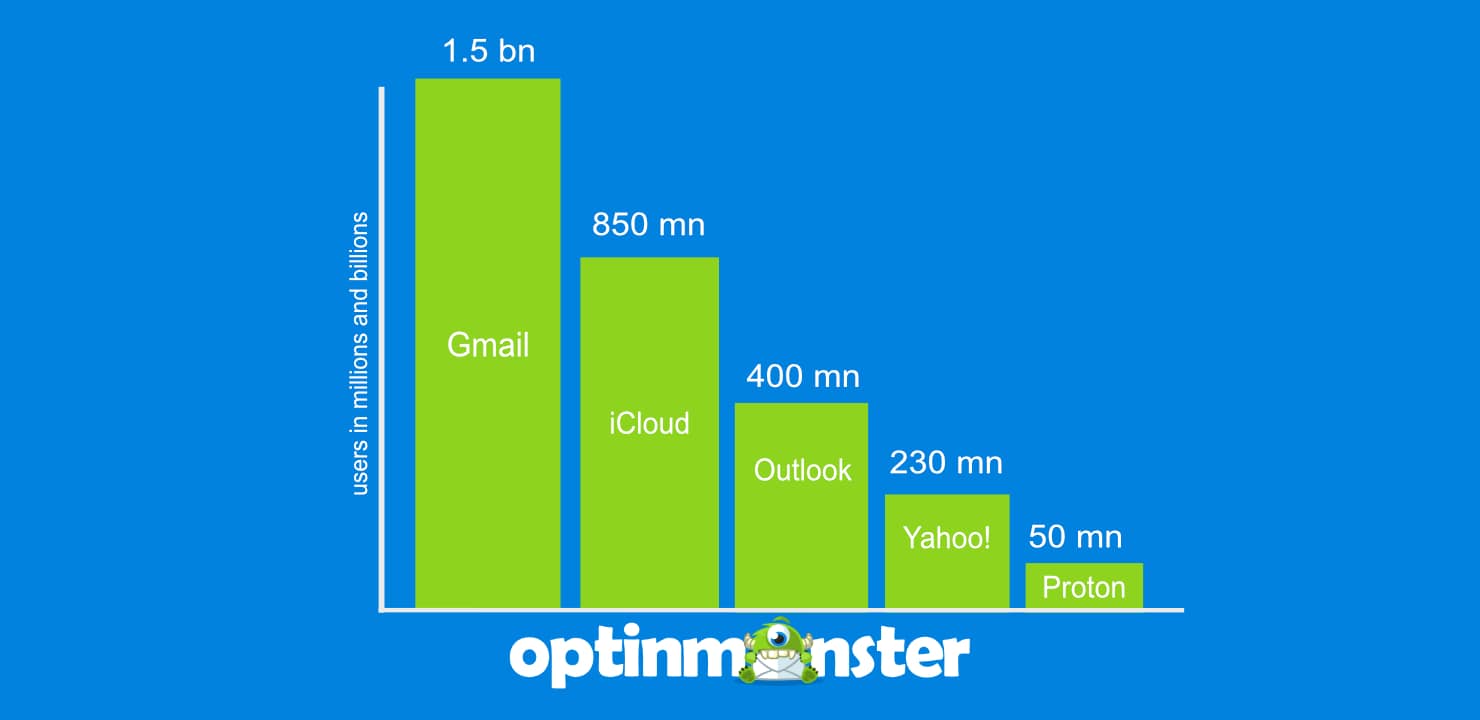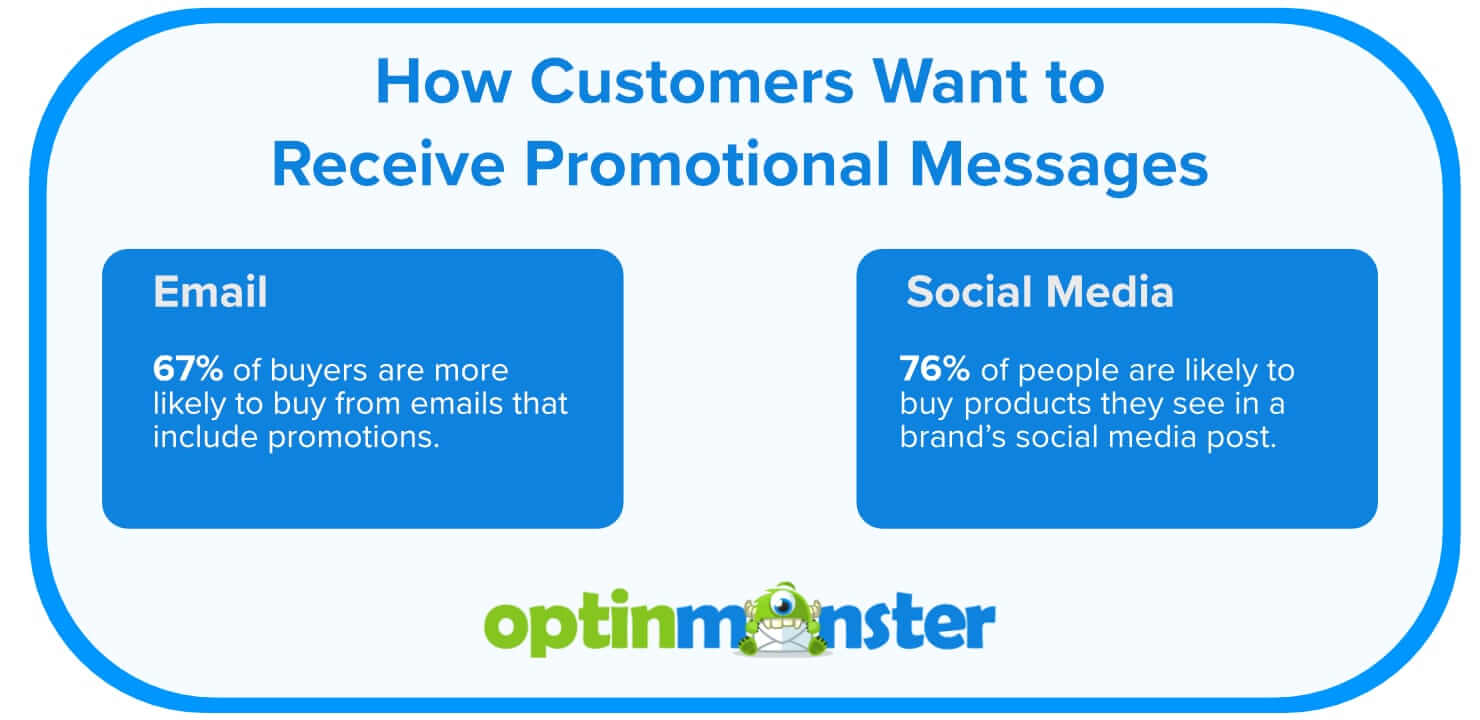Are you looking for sustainable ways to market your business? Not sure where to start: email marketing vs. social media?
Both email and social media marketing are promising channels to grow your business. But they also have their pros and cons.
In this post, we’ll share important insights into email and social media marketing. By the end of this blog, you’ll have a better idea of which platform works best for you to grow your brand.
Here are the topics we’ll cover:
- Overview: Email Marketing vs. Social Media Marketing
- Email Marketing vs. Social Media Usage
- Which Has Better Reach: Email or Social Media?
- Which Drives More Sales: Email or Social Media?
- Email Marketing ROI vs. Social Media ROI
- Which One Is Better: Social Media Marketing or Email Marketing?
Let’s get started!
Overview: Email Marketing vs. Social Media Marketing
Over the past decade, social media networks have grown exponentially. There are about 4.95 billion active social media users. This is a 138.2% jump from 2015, when only 2.08 billion people used social networks.
Today, social media is not just a fad but a viable digital marketing channel. Like email, you can use social media to reach your target audience. In fact, 43% of people use social media to research before buying.
Social media’s soaring popularity is helping thousands of online brands, especially eCommerce and small business owners. And marketers find themselves asking: will social media replace email?
But rest assured, email is not going anywhere.
When you look at email marketing’s effectiveness, it’s pretty clear that it’s an equally strong contender.
Email and social media aren’t mutually exclusive marketing tools. If you want to stand out in the competition, you have to leverage both social media and email marketing.
Email Marketing vs. Social Media Usage
There are more than 5.3 billion Internet users in the world. As stated earlier, 4.95 billion people have active social media accounts. That’s 61.4% of the world’s population!
But here’s the thing.
More than 4.37 billion people across the world also use email. You can’t invest in social media marketing at the expense of leaving out email marketing. Email marketing offers benefits that social media still lacks. We’ll talk about the pros and cons of both in the later sections.
Here are some interesting stats on email usage:
- 99% of email users check their inbox every day.
- 58% of people check emails first thing in the morning.
- 59% of Millennials and 67% of Zoomers check emails on smartphones.
Here’s how the data looks for people who prefer social media:
- About 27% of people visit social media right when they wake up.
- Typically, a social media user engages with an average of 6.7 different social media channels every month.
- The average user spends 2 hours and 24 minutes on their social media feeds daily.
- 40% of Gen Z prefer social media over Google to find answers to their questions.
Social media isn’t too far behind email in usage.
However, a better measure of each platform is how people use them in relation to their online buying habits.
According to HubSpot’s findings, 28% of consumers subscribe to a brand’s email list to receive promotional messages.
The number is more favorable for social media. 68% of customers say that they follow brands on social media to stay informed about new products.
This is great news for social media marketers!
Do you know what the most popular social media platforms are by user count? Here are the stats.
Top 5 Social Media Platforms Ranked by Monthly Active Users (MAUs)
What about email? According to stats, Gmail tops the list.
Top 5 Most Popular Email Service Providers
- Gmail: 1.5 billion users
- iCloud Mail: 850 million users
- Microsoft Outlook: 400 million users
- Yahoo!: 230 million users
- Proton Mail: 50 million users
Next, let’s break down the data by age group.
Global Usage of Email by User Age Group
- 15-24: 90%
- 25-44: 93.6%
- 45-64: 90.1%
- 65+: 84.1%
The common notion in marketing is that Gen Z doesn’t prefer email as much as social media. But these numbers prove otherwise. They are only slightly behind Millennials and Gen X in terms of their email usage.
Let’s see how social media fares in comparison. The number varies from platform to platform, but here’s a broader view.
Worldwide Social Media Usage by Age Group
- 13-19: 12.7%
- 20-29: 31.8%
- 30-39: 21.9%
- 40-49: 15%
- 50-59: 10%
- 60+: 8.6%
Unlike email users, the age gap and their usage preferences are pretty wide for social media followers. Not surprisingly, the 20-29-year-old age cohort is the largest user of social media.
To be fair, your potential customers might use these channels very differently. For instance, women aged 18-29 are the most likely to make purchases based on influencer content.
What does this mean for businesses? Gen Z likes subscribing to email newsletters as much as they love consuming social media content.
But be careful not to take a one-size-fits-all approach. Instead, use customer segmentation to target specific demographics and psychographics to maximize your marketing efforts.
Pro-tip: Learn about 50 smart ways to segment your audience so you can target your message to achieve higher conversion rates, regardless of the channel you use.
Which Has Better Reach: Email or Social Media?
It’s hard to bucket the average engagement rate of social media as a whole. Instead, here’s a breakdown of engagement rates by the leading social media channels.
- With 1,218 million MAUs, TikTok is the 6th largest social media platform. But it’s the #1 leader in terms of engagement.
- TikTok’s average engagement rate is 4.25%.
- That’s way more than Facebook (0.15%), Instagram (0.60%), and X (0.05%).
Your social media reach depends on platform-specific algorithms. Recently, LinkedIn changed its algorithms to prioritize posts that share “knowledge and insights.”
Organic reach in social media is growing tricky by the day. The more followers you gain, the harder it is to reach new customers.
Some of this is deliberate. Social media platforms are becoming a pay-to-play landscape because they want to monetize distribution.
In the context of email, there’s no such thing as organic reach. Instead, you can measure your email marketing campaigns through other important metrics:
- Number of email subscribers
- Click-through rate (CTR)
- Deliverability rate
- Unsubscribe rate
- Bounce rate
- Open rate
The number of email subscribers is unique to a brand or how effective their email optin campaigns are.
The average email click-through rate is 2.6-3%. Similarly, the average email deliverability rate is 85.7%.
The average email unsubscribe rate across all industries is 0.26%.
Brands that send too many emails usually have a higher unsubscribe rate. Anything less than 0.50% is a healthy metric.
Across most industries, the acceptable benchmark for email bounce rate is 2%. But it’s not uncommon for brands to have a 5-10% bounce rate.
And finally, the average email open rate across industries is 21.33%.
The verdict: Email and social media have different reach potential. You can’t compare them both because of the different nuances involved in growing an email list vs growing a social media following.
But you can use opt-in campaigns to grow both, your social media followers and email subscribers.
Did you know? OptinMonster is the best lead generation software that can help you monetize your website traffic. Learn how OptinMonster can help you get more email subscribers and grow your social media followers!
Which Drives More Sales: Email or Social Media?
Do emails work to drive sales? Yes, especially if you use emails to send promotional offers.
Research says 67% of consumers are more likely to buy from emails that include a coupon or discount.
But wait. Research says that 76% of customers are likely to purchase products they see in a brand’s social media post.
However, driving sales with social media can be challenging.
- Social media is an interactive medium. You constantly have to engage with a lot of followers in real time to get a few of them to convert.
- Your followers become tone-deaf when you start focusing too much on sales.
- Unlike in email, you have to juggle between multiple social media profiles just to keep your brand presence felt.
- You don’t own the customer data in social media. It belongs to the respective platform where you have your social media profile.
Deals and discounts are other factors that drive sales, especially in eCommerce. So where do brands go to promote their holiday campaigns or Black Friday sales?
Email is usually their go-to channel.
60% of buyers say they buy after receiving marketing emails from brands.
With social media, that number is higher. 90% of people buy from brands they follow on social media.
But like we stated above, social media marketing isn’t as scalable as email.
- With email, buyers don’t expect brands to engage in real-time. Email marketing uses the power of automation to stay engaged with customers.
- In general, email subscribers are more task-oriented. They approach brand interactions with specific goals in mind like finding deals, promotions, or new product information.
- You can use just one email marketing software to manage different email lists and customer groups.
- Email list is an owned media. There’s no 3rd-party platform dependency with email marketing. The audience that you build through email belongs solely to you.
There’s a lot more you can do with email marketing to improve your conversion metrics.
For example, you can create urgency in your marketing emails to further boost conversions. Using limited-time offers, flash sales, or countdown timers in email campaigns creates fear of missing out (FOMO) in people.
Using countdown timers is a smart conversion hack. Cosmetic Capital used OptinMonster to create a countdown timer on their floating bar and increased leads by 300%.
Remember, marketing emails don’t get good click-through rates if they aren’t optimized for clicks. A few tips to improve your email click-through rates are:
- Craft captivating subject lines
- Send highly personalized emails
- Send emails at the right time
- Routinely clean your email lists
- Test your email campaigns
Pro-tip: Emails landing in spam can also affect low click-through rates. If you don’t want your email marketing campaigns to land in spam, read through these useful resources:
- Why Are My Emails Going to Spam? Here Are 16 Reasons Why.
- 13 Email Deliverability Best Practices to Boost Your Inbox Reach
- Best Email Subject Lines: 184 Examples & Templates to Copy!
Bottom line: While social media is emerging as a promising channel to drive sales online, email marketing continues its streak as a bankable conversion channel.
Email Marketing ROI vs. Social Media ROI
There are different metrics to measure the effectiveness of any given channel. Most marketers agree that measuring the overall return on investment (ROI) of a channel is the most effective.
So which channel is more cost-effective: email marketing or social media?
The stats keep fluctuating from one year to another. Currently, the average ROI of email marketing is $36 for every $1 spent. This means you get 36 times the return for every dollar you spend on an email marketing campaign.
What about the ROI for social media marketing?
It’s tricky to calculate the ROI for social media marketing because it’s mostly organic. Experts place the ROI of paid social media marketing at $2.80 for every dollar spent.
It’s much easier to calculate the ROI by specific social media platforms. According to HubSpot’s 2023 Social Media Trends Report, here’s the ROI each social media platform offers:
- Instagram: 25%
- Facebook: 23%
- YouTube: 14%
- TikTok: 12%
- LinkedIn: 11%
- Twitter: 6%
Clearly, social media marketing offers so much more than email in terms of ROI. We suggest you increase your marketing budget on social but use email marketing to improve your marketing potential.
Pro-tip: Do you manage different social media profiles across different platforms? Read our post on the best social media management tools to simplify your social media marketing.
Which One Is Better: Social Media Marketing or Email Marketing?
Email marketing and social media marketing aren’t the same, and you shouldn’t see them as replacements.
Instead, incorporate both as an integral part of your content marketing strategy. Here are ways each of them can be used together for better results:
Email marketing is perfect for lead generation, customer engagement, and driving sales through promotions.
Social media is great for creating brand awareness, running giveaways, and driving traffic to your website. You can do that organically by making your content go viral or by paying for social media ads.
The type of content you share on these platforms also makes a difference. Social is best for leveraging user-generated content. Email is perfect for coupon marketing, sharing product updates, and monthly newsletters.
For best results, integrate them both into your marketing strategy. Use social networks to drive visitors to your website. And leverage the automation capabilities of an email marketing platform like Constant Contact to engage meaningfully with subscribers.
Need a headstart to boost your email conversions and signups? Get started with OptinMonster.
Do you have any thoughts about social media vs. email marketing? Share them with us in the comments!
Want to know how your social media marketing measures up? Check out these social selling statistics.
Disclosure: Our content is reader-supported. This means if you click on some of our links, then we may earn a commission. We only recommend products that we believe will add value to our readers.
